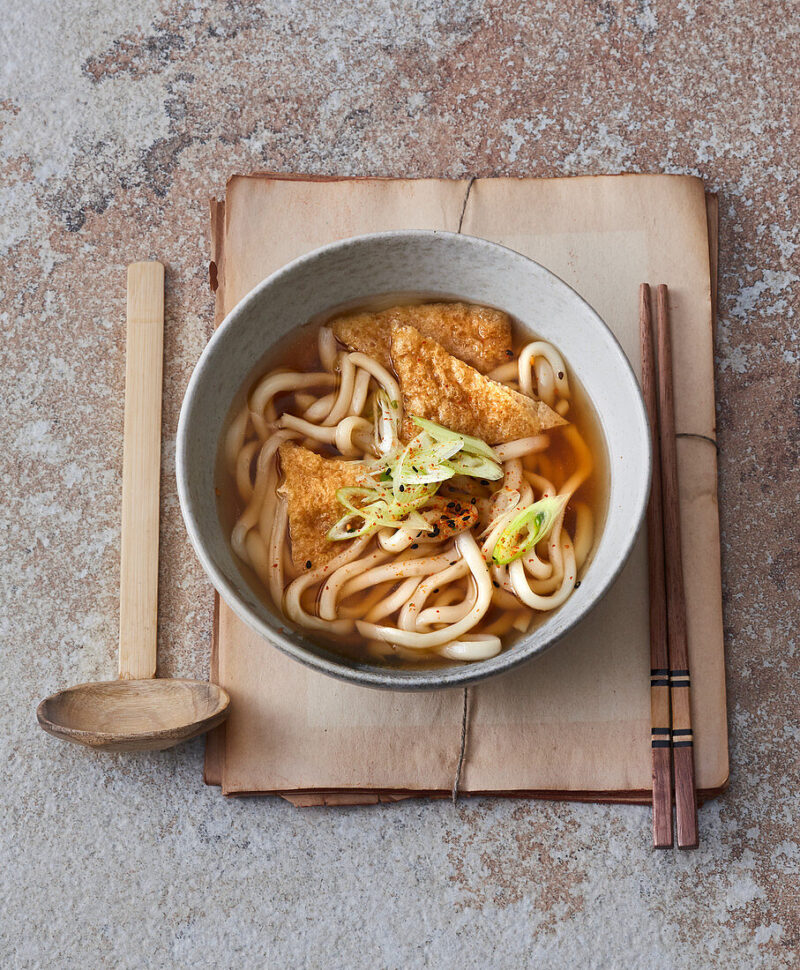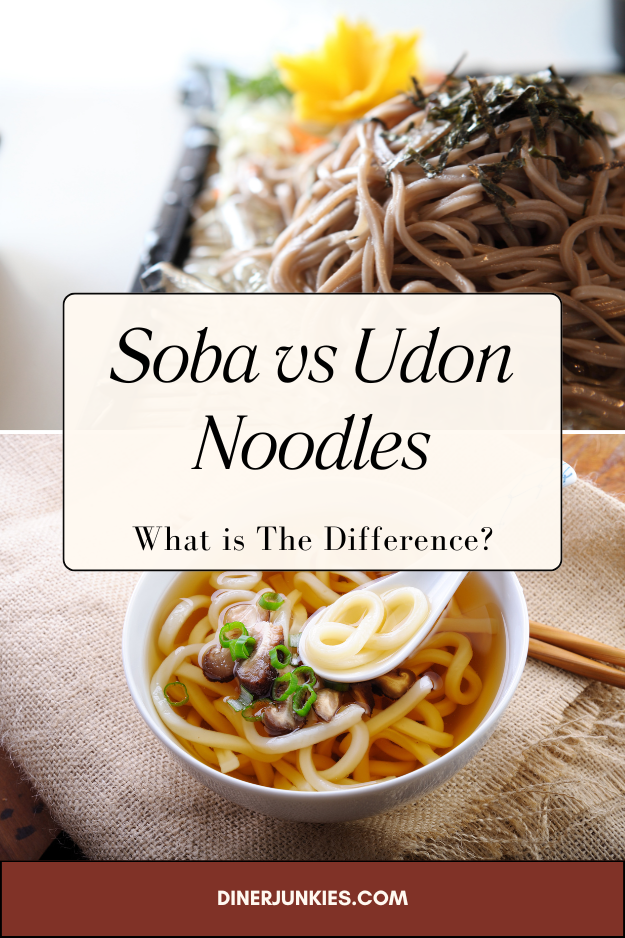If you’ve visited a Japanese restaurant, you might have seen soba and udon noodles. They taste good but are different. Soba noodles are made from buckwheat flour and have a nutty taste and chewy texture, ideal for soups or cold dishes. Udon noodles, made from wheat flour, are thick and smooth, perfect for hearty broths. Choose between the lightness of soba or the thickness of udon for a great meal.
The Basics of Noodles
Noodles are a staple food in many cultures. They come in various shapes, sizes, and flavours. You can enjoy them in soups, stir-fries, or even cold dishes.
Common Ingredients
Most noodles are made from similar ingredients. Here’s a quick list:
- Flour: This is the base for almost all noodles.
- Water: Used to mix the flour and form a dough.
- Eggs: Added in some types to make them richer.
Types of Noodles
There are many types of noodles around the world. Here are a few popular ones:
- Soba: Made from buckwheat flour, usually thin and brown.
- Udon: Made from wheat flour, thick and chewy.
- Rice Noodles: Made from rice flour, often used in Asian dishes.
Cooking Methods
You can cook noodles in several ways:
- Boiling: The most common method. Boil them in water until soft.
- Stir-frying: Toss cooked noodles in a hot pan with other ingredients.
- Cold Dishes: Some noodles, like soba, are served cold with dipping sauce.

Defining Soba Noodles
Soba noodles, originating in 8th century Japan, are made from buckwheat and are a key part of Japanese food, especially during New Year’s. They are versatile, being served hot in soups or cold with sauces.
Ingredients and Production
The main ingredient in soba noodles is buckwheat flour. This flour gives soba its unique earthy flavour and greyish-brown colour. Some versions mix buckwheat with wheat flour, which can alter the texture and taste.
To make soba, the flour is mixed with water to form a dough. The dough is then rolled out and cut into thin strips. This simple process helps keep the noodles light and chewy.
Soba’s Nutritional Profile
Soba noodles are known for their health benefits. They are high in protein and contain essential amino acids, which are great for muscle repair.
A typical serving of soba contains:
- Calories: About 200
- Protein: 10 grams
- Fibre: 4 grams
- Fat: 1 gram
Soba is also a good source of vitamins and minerals, including manganese and magnesium. It’s gluten-free when made with 100% buckwheat, making it suitable for those with gluten sensitivities.
Defining Udon Noodles
Udon noodles are thick, chewy noodles commonly used in Japanese food. They have a special texture and are very flexible. Here’s a simple guide on their history, making process, and nutritional value.
Udon noodles have been around in Japan for over a thousand years, possibly coming from China. Nowadays, they’re popular across Japan, with each place having its version, like Sanuki udon from Kagawa Prefecture. Udon is usually eaten in soups or stir-fries, both in restaurants and at home.
Ingredients and Making Process
Udon noodles are made from simple ingredients: flour, water, and salt. The specific type of flour used is usually high-gluten wheat flour. This gives the noodles a chewy texture.
To make udon, you mix the flour, water, and salt to form a dough. Then, you knead it, allowing the gluten to develop. After resting, you roll it out and cut it into thick strands. Fresh udon has a soft texture, while dried udon can be found in stores for convenience.
Nutritional Information
Udon noodles are a good source of carbohydrates, making them a great energy boost. A typical serving contains around 200 calories, depending on the preparation.
They are low in fat and have some protein, but not as much as other noodle types like soba. If you’re looking for added nutrients, consider serving udon with vegetables or lean proteins. This boosts both the nutrition and flavour of your meal.

Texture and Taste Comparison
Soba and udon noodles have different textures and tastes that can change the feel of your dish.
Soba noodles are made from buckwheat flour. They have a slightly nutty flavour and a firm, chewy texture. When you bite into them, they have a unique grainy feel.
Udon noodles, on the other hand, are thicker and made from wheat flour. They tend to be soft and smooth, with a comforting, chewy consistency. Udon is great at absorbing sauces, making each bite full of flavour.
Quick Comparison
| Feature | Soba | Udon |
|---|---|---|
| Main Ingredient | Buckwheat flour | Wheat flour |
| Texture | Firm and chewy | Soft and smooth |
| Taste | Nutty and earthy | Mild and hearty |
If you’re looking for something lighter with a unique taste, go for soba. If you prefer a heartier meal, udon is a solid choice. Each noodle brings its own experience to the table!
Common Ways to Serve Soba and Udon
Soba and udon noodles have their special ways of being served. Here are some popular ideas:
Soba
- Cold Soba: Served chilled with a dipping sauce called tsuyu. Perfect for hot days.
- Warm Soba: Enjoyed in a hot broth with toppings like green onions, tempura, or mushrooms.
- Soba Salad: Tossed with vegetables and a light dressing. It’s a refreshing meal.
Udon
- Udon Soup: Usually served in a warm broth with various toppings like fish cakes, tofu, or scallions.
- Stir-Fried Udon: Cooked in a stir-fry with vegetables and meat. It’s savoury and filling.
- Curries: Udon can also be served with curry sauce for a hearty dish.
Choosing Between Soba and Udon
When picking between soba and udon, think about what you want in a meal. Both types of noodles are tasty, but they have different textures and flavours.
Consider Your Dish
- Soba: Great for cold dishes or soups. It’s nutty and pairs well with light sauces.
- Udon: Thick and chewy, perfect for hearty soups or stir-fries.
Nutritional Value
- Soba: Made from buckwheat, so it’s higher in protein and packed with nutrients.
- Udon: Mainly made from wheat, which gives it a softer texture.
Dietary Needs
- If you’re gluten-free, go for soba if it’s 100% buckwheat.
- Udon contains gluten, so it’s not suitable for gluten-free diets.
Cooking Time
- Soba cooks quickly, usually around 4-5 minutes.
- Udon takes longer, about 8-12 minutes, depending on the thickness.
Cooking Tips for Soba and Udon
Cooking soba and udon noodles can be simple and fun. Here are some tips to help you get it just right.
Soba Noodles:
-
Rinse After Cooking: Once your soba is cooked, rinse it under cold water. This stops the cooking and helps remove excess starch. It keeps the noodles firm.
-
Water Temperature: Use plenty of water. Bring it to a rolling boil before adding the noodles. This helps them cook evenly.
-
Cooking Time: Check package instructions. Generally, soba takes about 4-6 minutes to cook.
Udon Noodles:
-
Don’t Skip the Boil: Like soba, make sure the water is boiling before you add the udon. This prevents sticking and makes for a better texture.
-
Cook Time: Udon noodles usually take 5-10 minutes. Check for a chewy yet soft texture.
-
Add to Dishes Immediately: Udon is best enjoyed straight after cooking. Keep it warm by adding it right to your broth or stir-fry.
Serving Suggestions:
-
For soba, try serving it cold with a dipping sauce or hot in a soup.
-
Udon is great in a broth or with a variety of toppings like tempura or green onions.
Related
Pairing with Broths and Toppings
When it comes to pairing, both soba and udon have their unique charm.
Soba Noodles
Soba works well with light broths. You can try:
- Dashi: A simple fish stock that highlights the noodle’s flavour.
- Miso broth: Adds depth and warmth.
For toppings, consider:
- Green onions
- Tempura
- Nori strips
These complement the earthy taste of soba.
Udon Noodles
Udon is thicker and chewier, so it loves heartier broths. Great options include:
- Soy sauce-based broth: Salty and rich.
- Curry broth: Adds a spicy kick.
For toppings, go for:
- Egg (soft-boiled or poached)
- Mushrooms
- Fish cake
These toppings enhance the comforting nature of udon.
In short, choose your broth based on the noodle. Pair soba with lighter flavours and udon with something more robust. This way, you’ll enjoy the full potential of each noodle!


